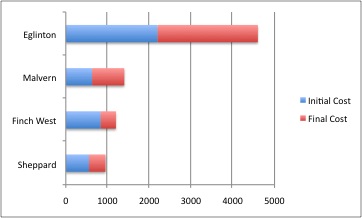 |
|
|
Transit CityAn important consideration in constructing the Downtown Relief Line early is its proposed routing from Pape Station north to Don Mills and Eglinton in the short term, and connecting with Sheppard in the long term. Under the current Transit City plan, the most likely option for the Don Mills LRT is to run from Pape Station north to Steeles via Pape, Overlea and Don Mills45. Though the Don Mills segment has yet to be refined in detail, an initial cost estimate put the line at $675 million70. This estimate was given at the initial unveiling of the Transit City plan, which at the time was projected to cost $6 billion. Since then, the costs projected for various lines in transit city have gone up dramatically. Sheppard, originally projected to cost $555 million (Mar. 2007) is now costing $950 million dollars157. Several other estimates for projects have escalated by a significant degree. Between the announcement of the project in March of 2007 and funding committed by the government in April of 2009, the project costs have gone up as follows: Sheppard: $555 million → $950 million (Increase of 71%) Overall, these four lines projected to cost $4.22 billion have already escalated in two years to $8.15 billion – or a cost overrun of 93% - even before construction begins. It would therefore be foolish to assume the cost of the Don Mills line to be merely $675 million; especially given the complications of the southerly routing. Using the 93% average cost overrun figure, we arrive at an estimated cost of $1.3 billion to build the Don Mills LRT. Until the environmental assessment proceeds, and a new estimate is given, exact figures are unknown, but it is clear that the southern portion of the line is going to be the more expensive end, requiring tunnelling through East York, where the right-of-way doesn't exist to put the LRT above ground45. It would not be unreasonable to expect the cost of the routing south of Eglinton to be anywhere between $600 and 800 million, depending upon complications. That figure could be even higher if the final estimate is more than 93% higher than the initial estimate, which seems very possible based on the low cost that included the necessary tunnelling south of the Don Valley, and the structural reinforcement required for the Leaside Bridge. If the Downtown Relief Line has any chance of being extended north of Bloor in its early development, this needs to be known before the Don Mills LRT commences construction and this money is wasted on something that would be replaced very shortly thereafter. The question then becomes whether or not it is necessary for the Downtown Relief Line to go north of Bloor in the short term. There are two important arguments for why the downtown relief line needs to be extended north of Bloor, either in the initial construction or in the second stage at the very latest. The first is to ensure further free capacity on the Yonge line. Peak demand on the Eglinton LRT line is expected to be 5400 passengers/hour52. Given the potential crowding already discussed on the Yonge line, the possibility to convince many of those passengers to transfer from the Eglinton LRT to the Downtown Relief Line rather than the Yonge subway can spread passengers out better throughout the system. The other important consideration is the pressure put on Pape Station if the Downtown Relief Line and the Don Mills LRT end at this location. Having three lines converge would make Pape a major transfer point, and it may not be able to handle all the passengers that would be transferring between the three lines. By extending the Downtown Relief Line further north, it eliminates one of the transfers, making the crowding more manageable, and shifting the transfer from the Don Mills line to the Downtown Relief Line north to Eglinton, whose passenger ridership is lower than that of Bloor, and where a new station could be built to accommodate the ridership levels, rather than trying to retrofit an existing station in a dense neighbourhood to accommodate ridership. As can be seen with the proposed changes to Bloor/Yonge station, reconfiguring an existing station to accommodate larger crowds can be a costly expense. Between the cost savings of not running the LRT as far as proposed, as well as the benefits of less crowding on Yonge and less pressure to put on Pape station, not to mention the benefits received by those in Thorncliffe Park and other stations between Bloor and Eglinton of not requiring a second transfer, it is important that the Downtown Relief Line begin construction soon to save these costs, and give passengers better service to downtown. |
